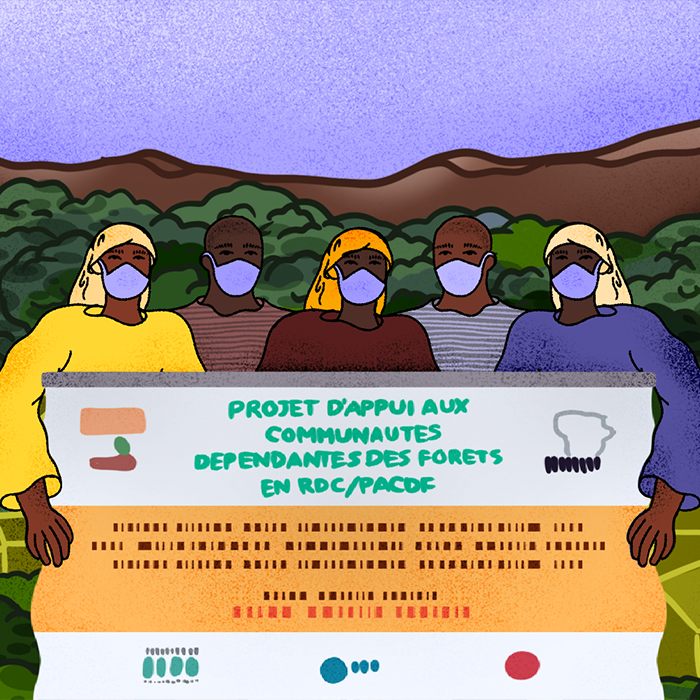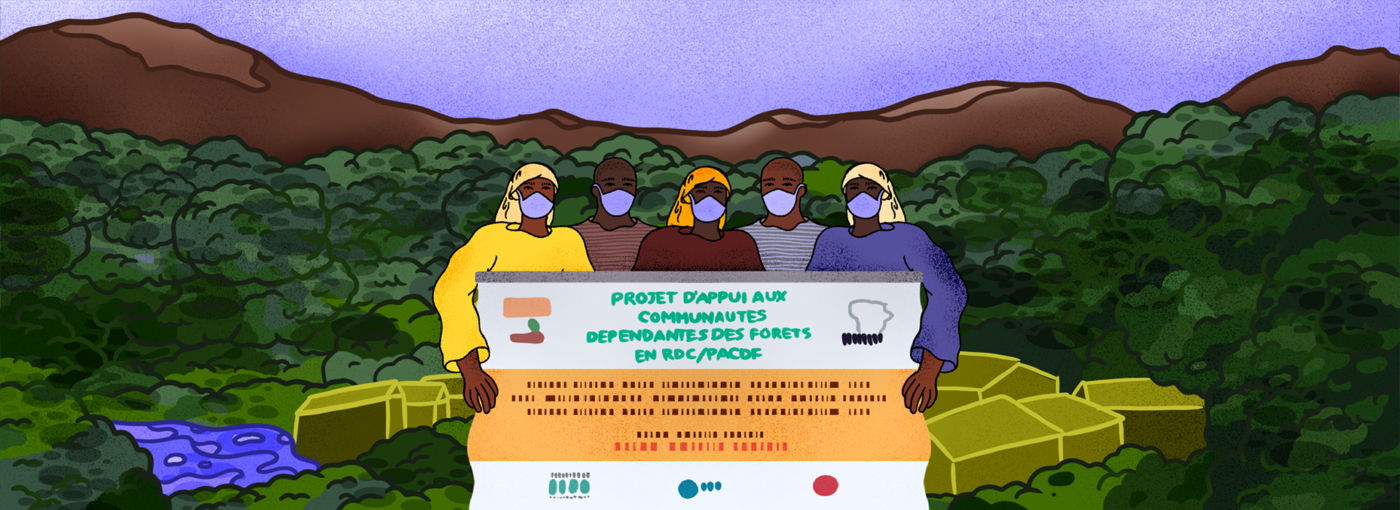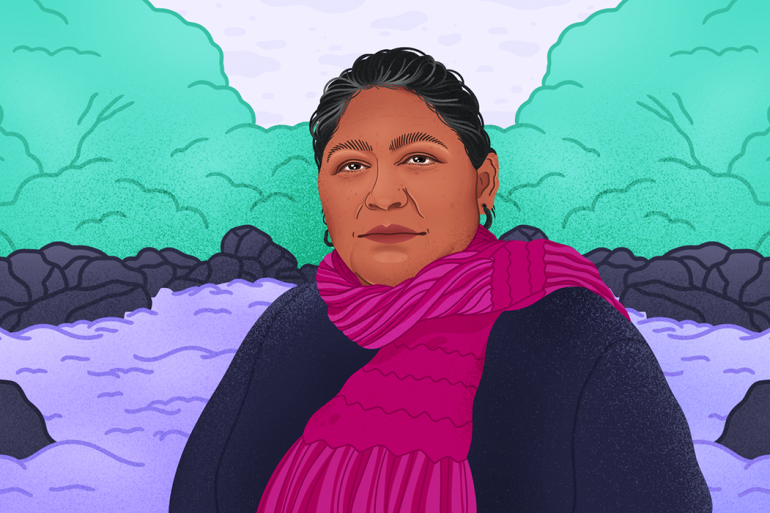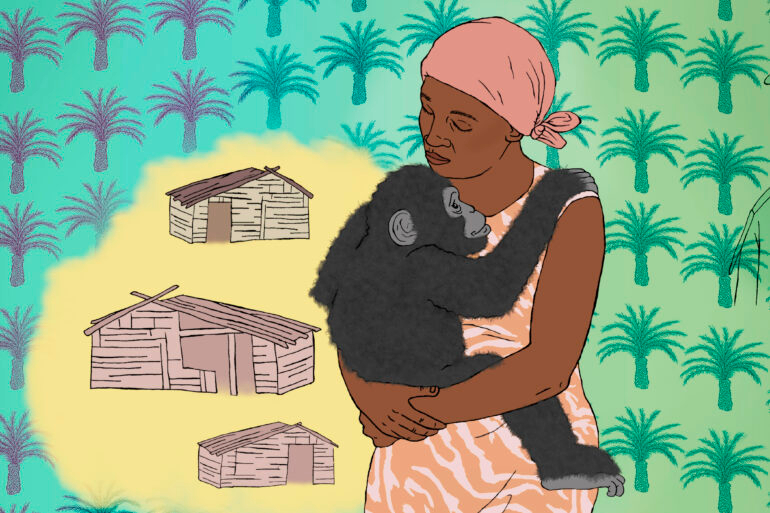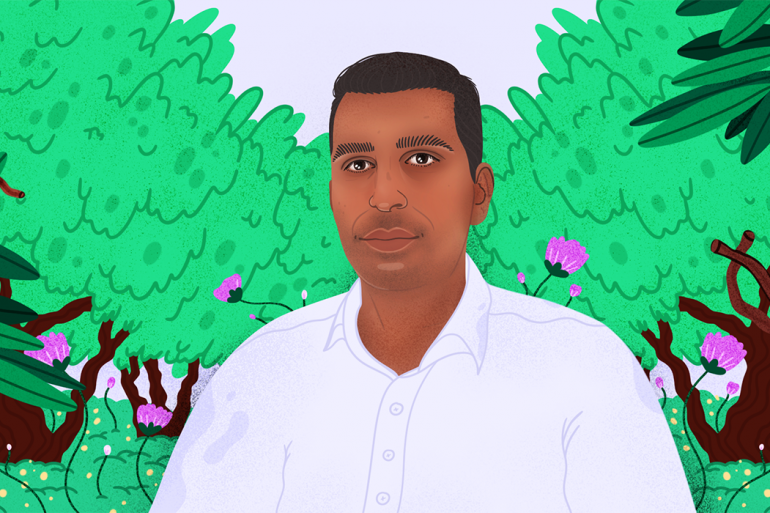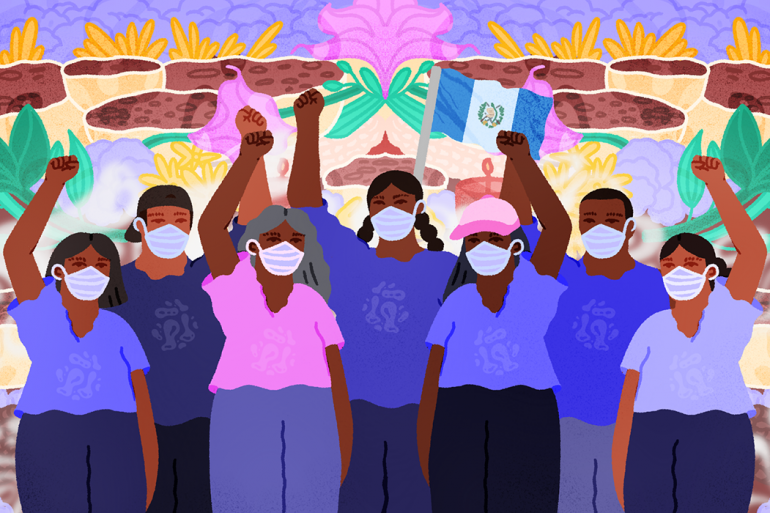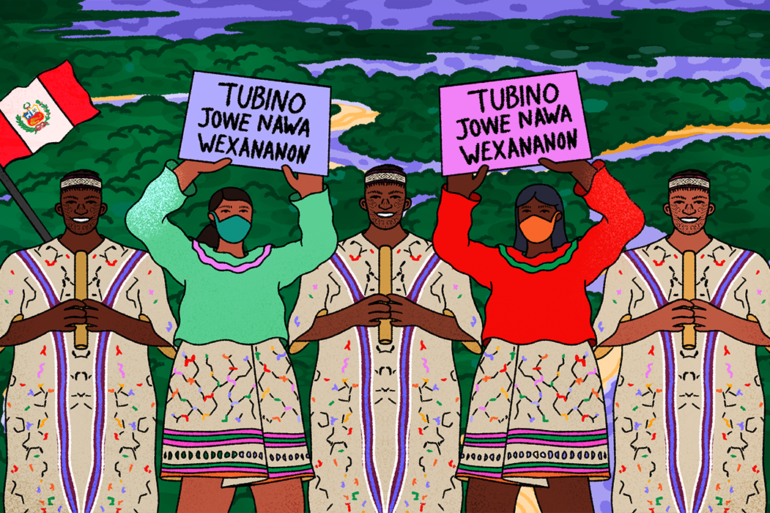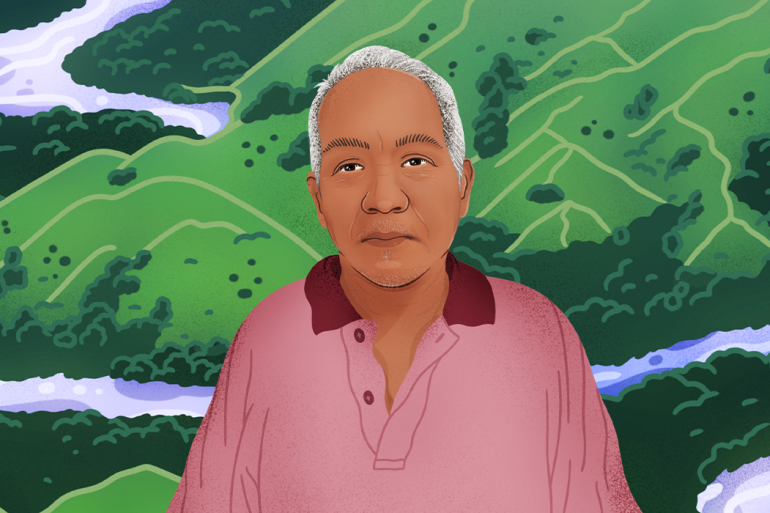With its rivers, forests, savannas and freshwater swamps, the Congo Basin – the second largest rainforest in the world after the Amazon – is a patchwork of treasures. It is home to approximately 10,000 species of tropical plants, as well as more than 400 species of mammals, 1,000 species of birds, and 700 species of fish, including several endangered species such as forest elephants or mountain gorillas.
Humans have shared the Congo Basin forests with these other species for tens of thousands of years. Today, the forests still provide food, fresh water and shelter to more than 75 million people.
I had the privilege of talking to Blair Byamungu Kabonge, an Indigenous Batwa descendent who was born in the South-Kivu region of the Democratic Republic of the Congo (DRC), where the Congo Basin connects with the Great Lakes region. Growing up in these lands, he has not only been a witness to nature’s beauty, but also its tragic ongoing destruction.
Together with its wildlife, Blair’s region is extremely rich in oil, diamonds, gold, copper, and minerals like cobalt, tin, cassiterite and coltan. This makes it ripe for extraction and exploitation, as these materials are used to produce new technologies such as smartphones and tablets as well as electric vehicles, solar panels and other so-called ‘green’ or ‘clean energy’ technologies.
Decades of violence
The economic interests in the minerals, timber and wildlife located in the region has attracted the interest of foreign countries and transnational companies over the past centuries, which has led to the explosion of violence.
This started with the colonisation of the territory by Belgium from the end of the 19th century. Attracted by its abundant wealth in rubber, ivory and minerals, the belgium crown, together with concessionary companies, undertook the brutal exploitation of its natural resources and population. Between 1880 and 1926, half of the inhabitants were killed, to the point that some historians refer to this period as a “forgotten holocaust”.
After the official independence of the country in 1960, the economic interests didn’t vanish, and more countries started to get involved in natural resources extraction, such as the United States, Canada, South Africa, the European Union or China, principally.
Locals and NGOs working in the region have long been calling out the direct link between the exploitation of natural resources and continuing armed conflicts in DRC.
Today, the Kivu region is still highly insecure, with multiple armed guerrilla groups, and a heavy presence of the Armed Forces of the Democratic Republic of the Congo (FARDC) which are guilty of violently exploiting civilians to extract valuable minerals to sell on to transnational companies.
“The wars we have are linked to the quest for control and domination over ecosystems,” Blair tells me. “But the rich countries chose to cover their ears. They do not seek to establish peace in eastern Congo; they know what they have to gain in this story. If the production of coltan stops in the Congo, what are you going to use to make your phones?”
The race for natural resources has been responsible for significant environmental damages, with devastating destruction of humid primary forests. According to Global Forest Watch, the total area of humid primary forests in South-Kivu decreased by 6.6% between 2002 and 2021.
The hypocrisy of international conservation plans
In light of the ever-worsening climate crisis – and despite the fact that local communities had been trying to give the alert for far longer – combating deforestation has begun to be seen by international institutions as a crucial step in limiting the impacts of climate change, as the world’s forests absorb roughly one-third of carbon emissions annually.
During COP26 in 2021, leaders from more than 100 countries pledged to halt deforestation by 2030.
A group of 11 countries, along with the Bezos Earth Fund, agreed to contribute $1.5bn toward restoration efforts in the Congo Basin region. At the latest COP conference that took place in November 2022, a Forest and Climate Leaders’ Partnership (FCLP) was launched to unite actions by governments, businesses and community leaders to implement the commitment made at the COP26.
However, this seems unrealistic given that there was a similar plan adopted in 2014, which sought to halve global deforestation by 2020 and end it by 2030… with absolutely no results so far.
Like many others, Blair does not really believe in international mechanisms that promote environmental protection. “After each international conference, agreements are signed, but if we get to COP27, it’s because it’s useless,” he says. “The initiators of these policies take people for idiots.”
The hypocrisy of these international declarations is hard to ignore, knowing that the countries that promote them are often the ones who benefit the most from (and contribute the most to) nature’s destruction.
“The same nations that run the COPs are the ones that own the industries that are destroying the planet,” agrees Blair. “So, are we going to start taking action, or are we going to stay distracted and carry on as if nothing is happening?”
I ask Blair what he thinks the answer should be. “What we need is for countries like France, the United States and Russia to reduce their production,” he says. “If we want to conserve the planet, we have to reduce! But which of these countries is taking real action? None!”
He continues: “Everybody says that the DRC is a poor country. And if you come here, it’s true, you’re going to find poor people. But these countries which you think are poor are still rich in forests – and that’s because the people have preserved them. We accept to live in misery, but we preserve nature. You refuse to live in misery, but you destroy the Earth!”
Subscribe to shado's weekly newsletter
Exclusive event news, job and creative opportunities, first access to tickets and – just in case you missed them – our picks of the week, from inside shado and out.

Conservation failures
During his lifetime, Blair has witnessed the failure of multiple conservation plans, one of which is directly linked to his homeland. His village is located at the edge of the Kahuzi Biega National Park (KBNP), a protected area of 6,000 square km situated near Lake Kivu and the Rwandan border. Established in 1970, it became a UNESCO World Heritage Site in 1980, and has been largely funded by the US and German governments. But far from providing protection, it seems like that designation has actually created the conditions for the acceleration of the sale and exploitation of animals and soils in the area.
“My village is located in the middle altitude of the Kahuzi-Biega National Park. As a child, I saw elephants. The park was one of the parks that attracted a lot of attention from tourists. Before the area officially became a national park, even if we made our livelihoods from hunting, there was everything. But when the white man came here and decided to create the park, that’s when the destruction started. The elephants are gone. Who organised the illegal sale of ivory? Who came to exploit the soils? The local communities or the people of the park, in collusion with the so-called “donors” who finance the park?” Blair challenges.
Blair left his region some years ago and now works in the North-Kivu region, near the city of Goma.
Here, he observes a similar case in the Virunga National Park. “Today, this park is the home of armed groups. And it’s called world heritage, it’s registered with UNESCO – and that makes me laugh. If it’s a world heritage, then what is the international community doing to knock the rebels out of the park? These armed groups threaten ecosystems and communities, they trade in species, they trade in minerals. But when the minerals come out of the park, they become “pure” in the eyes of white people, where in fact, they are made of blood.”
Sadly, this terrible situation is not specific to DRC: there are several other cases of conservation plans (designed by the UNESCO or other institutions and organisations) leading to a significant increase of violence and destruction throughout the world, such as in Central America.
Nature keepers
Blair is not just a witness, he has dedicated his life to defending the forests and Indigenous and local communities’ right to self-determination and self-organisation in their own land, because he knows that their destinies are closely related.
In fact, Indigenous peoples have been, and continue to be, nature’s best guardians on Earth: although they now represent only 6% of the world’s population, they protect 80% of the biodiversity that remains on the planet.
From speaking to Blair, it is clear that the land which Indigenous communities live on, and the natural resources which they depend on, are inextricably linked to their identity, culture and livelihoods, as well as their physical and spiritual well-being.
“For Congolese forest communities, the forest is everything,” Blair explains. “An inhabitant of a forest community can spend a year without buying anything, he does everything thanks to the forest: if he wants meat, he finds meat there; if he needs plants to heal himself, he finds them in the forest, if he wants to build, he doesn’t need nails since he finds ropes in the forest. The forest is life. The traditions of the people here conserve the forest.”
Yet now, the communities are faced with the risk of losing the forests on which their ways of life depend. Blair continues: “they know that if they end up being displaced, they have no place in the outside world, their way of life is absolutely different. They think: our life is here. To move us is almost to take us to the guillotine. We are not going to adapt to the way of life in the cities.”
Community forestry to protect the land
Throughout the world, Indigenous peoples often lack formal recognition of their lands, territories and natural resources. This puts them in a vulnerable situation and in a permanent state of war against companies and governments that seek to take control over their territories in order to exploit their natural resources.
Since 2017, Blair has been working as a community facilitator with the National Alliance for Support and Promotion of Indigenous and Community Heritage Areas and Territories in the DRC (ANAPAC-DRC). One of his main missions has been to support Indigenous communities to manoeuvre the slow bureaucracy and long legal processes necessary to assert their rights on their lands and forests.
In DRC, the soils and subsoils of protected forests belong to the State. However, according to Article 22 of the 2002 Congolese Forest Code, local communities can request a proprietary title on their forest, even if they are located in protected areas, if they can prove that they have a historical relationship with this territory.
When the communities receive their titles – which are collective and permanent, meaning that they won’t need to be renewed by future generations – they also obtain the right to manage their land in autonomy: they gain access to the right for self-determination and self-organisation in their territory.
With his organisation, Blaire has helped the Bambuti Indigenous community win land titles in the forest territory of Kisimbosa Chamsaka in the province of Nord-Kivu in 2019, becoming the first community forest in the region.
“It helps solve a lot of land issues. Without this, outsiders can easily come from Kinshasa and impose concessions. This brings a certain security”, explains Blair, even if he knows that there is no absolute guarantee that the communities won’t suffer from industry and economic pressure, and that the violence is not going to disappear with land titles.
However, he is sure that all of this is not just about property rights: the entire process also promotes collective organisation and solidarity between communities, which can be decisive when facing any type of threat.
“After obtaining their titles, communities are able to build projects such as schools at their local level, and then also open them up to other communities. One of our most important goals is connection: sometimes communities have a lot in common without realising it. Meeting each other allows them to learn from each other and to join forces for the protection of ecosystems,” he clarifies.
Building international awareness and solidarity
At the end of our conversation, I asked Blair about the responsibility of other people in the world with this same reality, and more precisely, what the people that will read his story can do to support local communities in Congo in their struggle for life.
One of the main things Blair says is building consciousness, especially among people that live in the Global North and asking: what are the impacts of living in rich countries on other peoples, and especially Indigenous peoples all over the planet?
Then, it is crucial to start holding the companies that are benefiting from the land’s destruction accountable for what they are doing: Which industries, and which products are made with blood? What can be done to stop them?
We must also build solidarity, and support those who are fighting everyday to protect not only their own lives but the planet we are all living on. Because, as Blair urges: “the biodiversity we have here in Congo is not just for ourselves, it is for everyone.”
What can you do?
- To know more about ANAPAC-DRC’s work:
- Check out what Global Witness has to say on DRC
- Familiarise yourself with this investigation on the violence Batwa communities are suffering in the Kahuzi-Biega National Park
- Visit Avispa Midia for more information on local and indigenous communities fighting against extractivism, principally in Latin America
- Read more articles in our land defender series HERE
